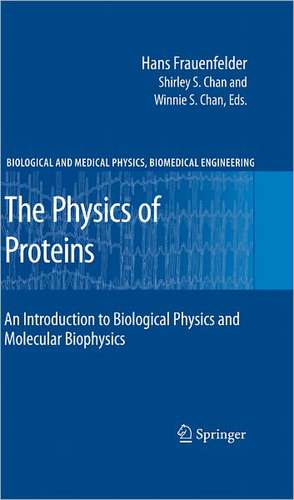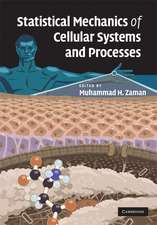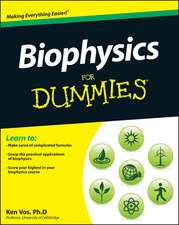The Physics of Proteins: An Introduction to Biological Physics and Molecular Biophysics: Biological and Medical Physics, Biomedical Engineering
Contribuţii de Robert H. Austin Autor Hans Frauenfelder Editat de Shirley S. Chan Contribuţii de Charles E. Schulz Editat de Winnie S. Chan Contribuţii de G. Ulrich Nienhaus, Robert D. Youngen Limba Engleză Hardback – 9 iun 2010
The discussion concentrates on physical tools and properties, emphasizing techniques that are contributing to new developments and avoiding those that are already well established and whose results have already been exploited fully
New tools appear regularly - synchrotron radiation, proton radiology, holography, optical tweezers, and muon radiography, for example, have all been used to open new areas of understanding
| Toate formatele și edițiile | Preț | Express |
|---|---|---|
| Paperback (1) | 704.50 lei 6-8 săpt. | |
| Springer – 5 sep 2012 | 704.50 lei 6-8 săpt. | |
| Hardback (1) | 956.81 lei 6-8 săpt. | |
| Springer – 9 iun 2010 | 956.81 lei 6-8 săpt. |
Din seria Biological and Medical Physics, Biomedical Engineering
- 5%
 Preț: 1110.32 lei
Preț: 1110.32 lei - 18%
 Preț: 1006.55 lei
Preț: 1006.55 lei - 18%
 Preț: 960.78 lei
Preț: 960.78 lei - 18%
 Preț: 704.10 lei
Preț: 704.10 lei - 18%
 Preț: 967.40 lei
Preț: 967.40 lei - 18%
 Preț: 948.92 lei
Preț: 948.92 lei - 15%
 Preț: 641.71 lei
Preț: 641.71 lei - 15%
 Preț: 644.95 lei
Preț: 644.95 lei - 15%
 Preț: 665.08 lei
Preț: 665.08 lei - 18%
 Preț: 1669.16 lei
Preț: 1669.16 lei - 18%
 Preț: 941.05 lei
Preț: 941.05 lei - 18%
 Preț: 950.21 lei
Preț: 950.21 lei - 15%
 Preț: 636.80 lei
Preț: 636.80 lei - 18%
 Preț: 947.50 lei
Preț: 947.50 lei - 15%
 Preț: 636.80 lei
Preț: 636.80 lei -
 Preț: 397.01 lei
Preț: 397.01 lei - 18%
 Preț: 1236.99 lei
Preț: 1236.99 lei - 15%
 Preț: 644.49 lei
Preț: 644.49 lei - 18%
 Preț: 946.55 lei
Preț: 946.55 lei - 15%
 Preț: 712.22 lei
Preț: 712.22 lei - 18%
 Preț: 952.89 lei
Preț: 952.89 lei - 18%
 Preț: 944.36 lei
Preț: 944.36 lei - 18%
 Preț: 1228.29 lei
Preț: 1228.29 lei - 5%
 Preț: 1422.67 lei
Preț: 1422.67 lei - 18%
 Preț: 1393.27 lei
Preț: 1393.27 lei - 15%
 Preț: 651.19 lei
Preț: 651.19 lei - 18%
 Preț: 953.65 lei
Preț: 953.65 lei - 18%
 Preț: 955.88 lei
Preț: 955.88 lei - 15%
 Preț: 644.95 lei
Preț: 644.95 lei - 5%
 Preț: 1098.48 lei
Preț: 1098.48 lei - 18%
 Preț: 959.19 lei
Preț: 959.19 lei - 15%
 Preț: 643.65 lei
Preț: 643.65 lei - 5%
 Preț: 1159.16 lei
Preț: 1159.16 lei - 5%
 Preț: 1102.67 lei
Preț: 1102.67 lei - 18%
 Preț: 952.09 lei
Preț: 952.09 lei - 18%
 Preț: 946.55 lei
Preț: 946.55 lei - 18%
 Preț: 952.09 lei
Preț: 952.09 lei - 15%
 Preț: 703.20 lei
Preț: 703.20 lei - 18%
 Preț: 953.65 lei
Preț: 953.65 lei - 5%
 Preț: 1008.41 lei
Preț: 1008.41 lei - 15%
 Preț: 644.82 lei
Preț: 644.82 lei - 18%
 Preț: 956.03 lei
Preț: 956.03 lei - 15%
 Preț: 647.40 lei
Preț: 647.40 lei
Preț: 956.81 lei
Preț vechi: 1166.84 lei
-18% Nou
Puncte Express: 1435
Preț estimativ în valută:
183.08€ • 191.15$ • 151.53£
183.08€ • 191.15$ • 151.53£
Carte tipărită la comandă
Livrare economică 04-18 aprilie
Preluare comenzi: 021 569.72.76
Specificații
ISBN-13: 9781441910431
ISBN-10: 1441910433
Pagini: 464
Ilustrații: XVI, 448 p. 221 illus., 7 illus. in color.
Dimensiuni: 155 x 235 x 34 mm
Greutate: 0.77 kg
Ediția:2010
Editura: Springer
Colecția Springer
Seria Biological and Medical Physics, Biomedical Engineering
Locul publicării:New York, NY, United States
ISBN-10: 1441910433
Pagini: 464
Ilustrații: XVI, 448 p. 221 illus., 7 illus. in color.
Dimensiuni: 155 x 235 x 34 mm
Greutate: 0.77 kg
Ediția:2010
Editura: Springer
Colecția Springer
Seria Biological and Medical Physics, Biomedical Engineering
Locul publicării:New York, NY, United States
Public țintă
GraduateDescriere
Physics and the life sciences have established new connections within the past few decades, resulting in biological physics as an established subfield with strong groups working in many physics departments. These interactions between physics and biology form a two-way street with physics providing new tools and concepts for understanding life, while biological systems can yield new insights into the physics of complex systems. To address the challenges of this interdisciplinary area, The Physics of Proteins: An Introduction to Biological Physics and Molecular Biophysics is divided into three interconnected sections. In Parts I and II, early chapters introduce the terminology and describe the main biological systems that physicists will encounter. Similarities between biomolecules, glasses, and solids are stressed with an emphasis on the fundamental concepts of living systems. The central section (Parts III and IV) delves into the dynamics of complex systems. A main theme is the realization that biological systems, in particular proteins, do not exist in unique conformations but can assume a very large number of slightly different structures. This complexity is captured in the concept of a free energy landscape and leads to the conclusion that fluctuations are crucial for the functioning of biological systems. The final chapter of this section challenges the reader to apply these concepts to a problem that appears in the current literature. An extensive series of appendices (Part V) provide descriptions of the key physical tools and analytical methods that have proven powerful in the study of the physics of proteins. The appendices are designed to be consulted throughout the section on protein dynamics without breaking the deductive flow of the logic in the central section of the book.
Cuprins
Biomolecules.- The Hierarchy of Living Things.- Information and Function.- Biomolecules, Spin Glasses, Glasses, and Solids (R. H. Austin1).- Proteins.- Nucleic Acids.- The Genetic Code.- Lipids and Membranes.- Spatial structure of proteins: measure-.- The Secondary Structure.- Tertiary Structure of Proteins.- Myoglobin and Hemoglobin.- The energy landscape and dynamics of.- Conformational Substates.- The Organization of the Energy Landscape.- Reaction Theory.- Supercooled Liquids and Glasses.- Function and dynamics.- Protein Dynamics.- Protein Quantum Dynamics? (R. H. Austin1).- Creative Homework: Dynamics and Function.- Appendices: tools and concepts for the.- Chemical Forces.- Acids and Bases for Physicists.- Thermodynamics for Physicists.- Quantum Chemistry for Physicists.- Energy Levels from Nuclei to Proteins.- Interaction of Radiation with Molecules.- Water (R. H. Austin1).- Scattering of Photons: X-Ray Diffraction.- Electronic Excitations.- Vibrations.- The Nucleus as a Probe (C. E. Schulz1).- Nuclear Magnetic Resonance and Molecular Structure Dynamics (R. H. Austin1).- Neutron Diffraction.
Recenzii
From the reviews:
“It appears to be written for advanced undergraduates and graduates in physics who are newcomers to biophysics and biochemistry. … The book builds from Frauenfelder’s sketches and hand-drawn diagrams, which impart to the volume a personal touch, to its major theme: Frauenfelder’s insight that protein structures undergo conformational transitions – proteinquakes – through sub-states of approximately equal energy in a rugged, multi-dimensional, conformational-energy landscape.” (H. Richard Leuchtag, Physics Today, May, 2011)
“It appears to be written for advanced undergraduates and graduates in physics who are newcomers to biophysics and biochemistry. … The book builds from Frauenfelder’s sketches and hand-drawn diagrams, which impart to the volume a personal touch, to its major theme: Frauenfelder’s insight that protein structures undergo conformational transitions – proteinquakes – through sub-states of approximately equal energy in a rugged, multi-dimensional, conformational-energy landscape.” (H. Richard Leuchtag, Physics Today, May, 2011)
Notă biografică
A leader in physics research for more than half a century, Hans Frauenfelder spent 40 years as a professor and researcher at the University of Illinois before moving on to Los Alamos Laboratory, where he was the director of the Center for Nonlinear Studies and is now a Laboratory Fellow. Frauenfelder has been elected to the National Academy of Sciences, the American Academy of Arts and Sciences, the Academy Leopoldina and the American Philosophical Society. He also is the recipient of numerous prestigious scientific fellowships and honors.
Textul de pe ultima copertă
Physics and the life sciences have established new connections within the past few decades, resulting in biological physics as an established subfield with strong groups working in many physics departments. These interactions between physics and biology form a two-way street with physics providing new tools and concepts for understanding life, while biological systems can yield new insights into the physics of complex systems. To address the challenges of this interdisciplinary area, The Physics of Proteins: An Introduction to Biological Physics and Molecular Biophysics is divided into three interconnected sections. In Parts I and II, early chapters introduce the terminology and describe the main biological systems that physicists will encounter. Similarities between biomolecules, glasses, and solids are stressed with an emphasis on the fundamental concepts of living systems. The central section (Parts III and IV) delves into the dynamics of complex systems. A main theme is the realization that biological systems, in particular proteins, do not exist in unique conformations but can assume a very large number of slightly different structures. This complexity is captured in the concept of a free energy landscape and leads to the conclusion that fluctuations are crucial for the functioning of biological systems. The final chapter of this section challenges the reader to apply these concepts to a problem that appears in the current literature. An extensive series of appendices (Part V) provide descriptions of the key physical tools and analytical methods that have proven powerful in the study of the physics of proteins. The appendices are designed to be consulted throughout the section on protein dynamics without breaking the deductive flow of the logic in the central section of the book.
Caracteristici
The discussion concentrates on physical tools and properties, emphasizing techniques that are contributing to new developments and avoiding those that are already well established and whose results have already been exploited fully
New tools appear regularly – synchrotron radiation, proton radiology, holography, optical tweezers, and muon radiography, for example, have all been used to open new areas of understanding
Includes supplementary material: sn.pub/extras
New tools appear regularly – synchrotron radiation, proton radiology, holography, optical tweezers, and muon radiography, for example, have all been used to open new areas of understanding
Includes supplementary material: sn.pub/extras












